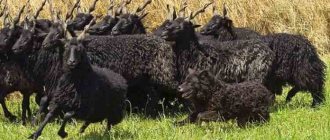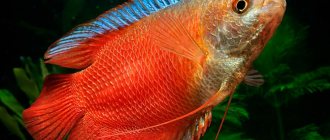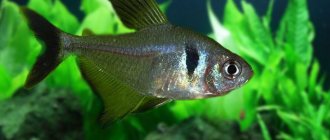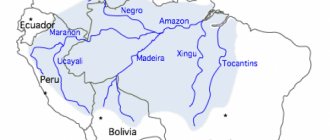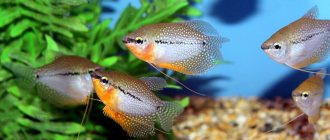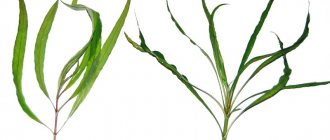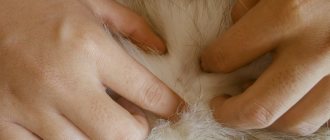Marbled gourami (Trichogaster trichopterus cosby / opaline)
A selective species obtained by crossing blue and spotted gourami. Fish with an unusual “marble color” were first discovered by the American Cosby. It was he who developed the species that exists today.
Synonyms
Russian: Gourami opal
Order: Crawler-like (Anabantiformes) Family: Macropods or Guramis (Osphronemidae) Genus: Trichogaster or Gourami-threaders (Trichogaster)
Marbled gourami in nature
Naturally, it is impossible to meet artificially bred individuals in the natural environment. But their parents, blue gourami, to which representatives of the marbled variety are very similar, live in Asian countries. They can be found in Indonesian, Sumatran, and Thai reservoirs. To live, fish choose low-lying areas that are flooded with water.
Most often, gourami inhabit swamps, irrigation canals, rice fields, streams, and ditches. Most of all, natural, abundantly overgrown reservoirs with standing water are suitable for their habitat. During the rainy season, these inhabitants begin to migrate from the river, and during drought they return back. In nature, blue gouramis eat insects and bioplankton.
The development of a new marble variety is associated with the name of the American breeder Crosby. It was he who was the first to obtain fish with such an unusual color, and at first they were called Crosby, but gradually the name changed to the one that is still used today.
Occurrence and features
The variety was bred by scientists by selecting spotted gourami. At first the name was associated with the surname of the founding breeder Cosby. Later it changed to today's version. The coloring of the fish is similar to marble, which gives the variety its name. Gourami is one of the unusual labyrinth fish. Their characteristic difference is the ability, with the help of a special organ, to use oxygen from the atmosphere for breathing. Pisces are peaceful. They live in the upper and middle water levels. They live on average from 4 to 6 years.
Since the variety was bred artificially in laboratories, it cannot be found in nature. The “parent”, the common spotted gourami, is found in the southeast Asian zone. This fish chooses to live in lowlands filled with water: swamps, streams, ditches. She loves places where there is no current, but there is a large variety of aquatic plants.
When the rainy season comes, gouramis move to areas where there is a flood. In nature, fish eat plankton and various small insects. The last gouramis are knocked down with a thin stream of water, which is released from the mouth. Under natural conditions, the signal for reproduction is a change in water hardness, which is associated with warm spring rains.
Appearance and color of fish
Representatives of this species are quite large individuals - the length of some fish reaches 13 cm:
- The body of marbled gourami is oval-shaped, resembling a leaf with compressed sides;
- the anus is located not far from the head, the fin is located immediately behind it - it is elongated and reaches the base of the tail;
- the color of the anal fin continues with the body - it is covered with spots and has a border, in some individuals it is reddish;
- dorsal fin shortened;
- pectoral fins of medium length, almost always colorless;
- the tail is divided in the middle by a small notch.
The fish are interestingly colored: the light gray body is covered with gray spots of various shapes. All fins, except for the transparent pectoral ones, are dark gray in color and covered with a large number of yellow spots.
Differences between the sexes in pets
It is difficult at first to distinguish a male gourami from a female, like many other fish. Before puberty, they are almost the same, since a girl grows faster than a boy. Then the sexes develop characteristic characteristics. The most reliable is the shape and size of the dorsal fin. The fin of the male is longer and pointed. For girls it is shorter and round.
The fish also differ in size. Females are smaller and noticeably plumper. The structure of the anal fin will also help determine the sex of the pet. In the “lady” it is shorter and has a rounded shape, in the male the fin has a pointed shape. It is also distinguished by its bright coloring, which intensifies before spawning. The behavior of the fish will also help determine their gender. Boys are more aggressive than girls. Before breeding, the male chases his partner. Also, “men” show aggression towards each other.
Knowing the gender of gourami is useful in the following cases:
- when introducing fish: if you put two male gourami in a small aquarium, they will compete with each other, it is better to introduce fish of different sexes, or the house should be large so that the pets divide the territory;
- during reproduction: without knowing the sex of the fish, you can miss spawning time or place a couple of individuals of the same sex for mating.
Have any of you tried breeding marbled gourami? Share your experience in the comments. Like and share the article if you find answers to your questions in it - it will probably be useful for others.
Possible difficulties in content
Almost all gouramis, regardless of variety, are unpretentious aquarium inhabitants. Even beginners who are not particularly familiar with the peculiarities of aquarium farming can keep such fish.
They are not picky about food and are able to live in different conditions. They get along well in common tanks. However, it is worth considering that male gourami are quite pugnacious, and their aggression is directed at competitors of the same breed, regardless of their color.
In which aquarium do fish breed?
If you are planning breeding in a common tank, it is advisable that it have a volume of at least 100 liters and a height of at least 50 cm. Since gouramis rise to the surface from time to time to breathe air, a pregnant female or future father may jump out and die. For this reason, the aquarium is covered with a lid.
We recommend reading
Maintenance and reproduction of handsome chromis
Gouramis like to have a lot of vegetation around, but at the same time, they need space for free swimming. They don't eat plants, so any algae will do, even those with a delicate texture. Grottoes and driftwood are also welcome. Together with algae, they will serve as shelter for pregnant females during the period of persistent courtship by the male.
Feeding regimen and diet
Marbled gouramis are omnivores; in their natural environment, their menu mainly consists of insects and larvae. In captivity, they eat almost any food - artificial, live or frozen. The basis of the diet can be prepared foods in the form of granules or flakes.
You can supplement the menu of aquarium inhabitants with live food - bloodworms, tubifex, coretra, and brine shrimp. Almost all fish of this breed have one ability - they can catch insects that fly over the water. They shoot a stream of water at them from their mouths and grab the prey that has fallen into the water.
Nutrition
The fry will grow best if you feed ciliates and nauplii of crustaceans. Some aquarists practice feeding boiled egg yolk, but this may not give good results.
Many fish don’t mind eating a regular cucumber.
Adult fish are not picky eaters; moreover, they are not afraid of parasites such as hydra or planaria. Preferable, of course, is live food: bloodworms and tubifex. With appetite, marbled gouramis eat raw meat, if it is finely scraped, as well as finely chopped lettuce or dandelion leaves.
Dry and frozen food can be used, but not as the basis of the diet.
Aquarium maintenance of marbled gourami
Young animals are suitable for keeping in a 50-60-liter tank, but adults require a larger home - at least 80 liters. Since these fish need atmospheric air, it is important that the temperature conditions of the water and air environments do not differ much. Gourami do not need current, this should be taken into account when installing a filtration system. There is no special need for aeration.
The aquarium must be well landscaped - this is important for the comfortable living of the inhabitants, since in the thickets these fish will hide from their more conflicting counterparts. It is important that the vegetation does not completely occupy the aquarium - the fish need space for free swimming. It is also recommended to use driftwood, grottoes, and stones as decoration, which make excellent shelters.
Gourami have a high adaptability, but the following water parameters are considered ideal:
- temperature – from 23° to 28°C;
- pH value – 6.0-8.8;
- hardness – 5-35 dGH.
The fish themselves do not really need lighting, but with electric light they look more impressive, their silvery scales begin to shine and shimmer.
Care and maintenance
Since marbled fish swim closer to the surface of the water, the type of soil does not matter much, but the marbled color looks better against a dark background. The aquarium is decorated with a large amount of algae. To monitor pets, leave free space at the front wall. The back and side areas are planted with elodea, pinnate, and cryptocoryne. Floating duckweed, piscia, and salvinia protect pets from the sun's rays. To bring the habitat closer to natural, stones, driftwood, and shards are laid out on the ground.
An aquarium for gourami should be equipped with plenty of hiding places and be equipped with dim light.
Another important point in arranging an aquarium is the choice of a filter attachment that controls the strength of the current.
Insufficient aeration of a home pond is compensated by the marbled gourami’s ability to use atmospheric air.
To create comfortable living conditions, fish need an aquarium with a capacity of 50 liters or more, compliance with water requirements.
| Volume of water (liters per 1 individual) | Temperature (°C) | Acidity (pH) | Hardness (dGH) |
| 7 – 8 | 23 – 28 | 6,5 – 7,5 | 5 – 20 |
The cover glass on the aquarium levels out the difference in water and air temperatures, which prevents weakening of the immune system and illnesses of pets. However, in this case, gourami cannot use the labyrinth for breathing, so the aquarium must have a well-established aeration system.
Caring for a reservoir consists of replacing 20% of the total volume of water, periodically cleaning the walls, decorative elements, and soil from plant and food residues and walls. Overgrown plants require pruning and removal of dead leaves.
Unpretentious gouramis are omnivores, but to maintain health they are offered alternately dry, vegetable, and live food. The fish, deprived of their usual food for several days, feed on algae.
Who do marble gouramis get along with?
You should not place nimble or very large fish in the same aquarium with gouramis. These fish do not have the best companionship with the too small, arrogant inhabitants who pluck their fins. They don't get along with:
- Sumatran barbs;
- cichlids;
- cockerels;
- parrots;
- astronotuses;
- goldfish.
Marbled gouramis can compete with discus, shrimp and guppies. The result of such a neighborhood is that some will eat others. It is dangerous to put a gourami and a single macropod in the same tank; it will bully everyone, tearing off fins and intimidating the young. The matter may end in the death of smaller inhabitants.
But with whom marbled gouramis get along worst of all, it is with their own kind. The only way to reduce conflict is to form a flock in such a way that there are several females per male. In addition, gourami often do not get along with other representatives of the breed. For example, it is not recommended to house pearl individuals with marbled ones or the latter with blue ones.
However, these fish can still be kept with other inhabitants, for example, with:
- boots;
- small barbs;
- neon;
- iris;
- zebrafish;
- swordtails;
- catfish: ancistrus, cockroach, sacbranch, etc.;
- scalars;
- tetras;
- minors.
Pet character and compatibility
Gourami gets along quite well with other fish, but the boys often fight among themselves. It is better to introduce a couple into the aquarium or create places where weak fish can hide. Calm, peaceful pets of similar size are chosen as neighbors for them. Poor proximity to pugnacious species is harmful to more sedate gouramis. During the breeding season, only one species and only one pair are left in the tank.
Species with which the neighborhood will be successful:
- minors;
- angelfish;
- neons;
- rasboras;
- catfish.
Incompatibility occurs with the following types:
- labidochromis of all types;
- parrots;
- goldfish;
- all cichlids.
Remember that the right neighbors are the key to the health of all inhabitants of the aquarium.
How to distinguish males and females
The main sexual difference in gourami is the shape of the anal and dorsal fins. In females they are round, and in males they have pointed ends. In addition, males that have reached sexual maturity are larger than females. The latter have a less flattened body, which is why they look thicker.
Among young fish, detecting males and females is a difficult task, since before puberty the fish have no physiological characteristics. They can reproduce from 6-8 months of age, and males in some cases turn out to be more “precocious.”
What to feed your fish
Marbled gourami does not require complicated feeding. Different types of feed are used for nutrition:
- live (for example, brine shrimp and bloodworms);
- dry;
- frozen;
- vegetable (finely chopped dandelion leaves).
The fry will grow well if fed with ciliates and nauplii of crustaceans. Feeding dry food contributes to greater mortality of fry. When choosing food, it is important to pay attention to the size of its particles, since gourami have a small mouth. Food should be varied. Feeding frequency – 1-2 times a day in small portions.
Gourami breeding
Like other labyrinth fish, male gourami build a nest from salivary fluid and air bubbles. The female lays her eggs in it, and here they remain until the fry emerge. And the babies are in the nest for the first time. Breeding fish of this type is not difficult - just arrange a landscaped tank with a spacious water surface.
Expectant parents should be fed live diets for a week or a week and a half. A female “in pregnancy” is revealed by her noticeably plumper and rounded abdomen. The couple should be placed in a 50-70 liter spawning aquarium, the water thickness of which is up to 15 cm, and the temperature is 26°-27°C.
The homely male begins to build a nest, most often in the corner of the tank. At this time, he can treat the female harshly, and she must have a place where she can hide from him. When the nest is ready, the fish begin mating games - the male rushes after the female, melting his fins. The male carefully helps the female during the laying of eggs and fertilizes them.
When spawning is completed, it kicks out the “wife”. At this moment, the fish should be immediately removed, since the father is capable of killing it. He remains to take care of the eggs and the resulting offspring. When the fry leave the nest, the male should be returned to the common tank, as he can eat the lovingly reared babies. The fry can be fed ciliates and microworms until they grow up. Artemia nauplii are then introduced into their diet.
Marbled gourami are beautiful and picky aquarium inhabitants that can decorate any tank. And in order to keep them in society with other residents, it is necessary to select “neighbors” carefully so that peace and grace reign in the underwater world.
Completion of mating and appearance of offspring
At the end of spawning, the male becomes aggressive. He drives the female away from the nest and with all his appearance demonstrates his reluctance to tolerate her presence. At such moments, many females lose their tails and fins, because the father gives a real beating to his overly annoying girlfriend. The weakest of them even die.
Only the father takes care of the common offspring, protecting the precious eggs. Mom does not show any interest in the laying, although there are times when she tries to intervene in the process, but is quickly rebuffed . For all the above reasons, after spawning, the female is placed back in a large aquarium; she will be ready to breed again in 3-4 weeks.
The incubation period is 35-36 hours, and then the fry emerge. They look like little hooks with big eyes. After 4-5 days, the larvae become like real fish.
We recommend reading
What you need to know about breeding betta fish
When the larvae appear, the father is also removed. His instincts are noticeably weakened and lose their meaning. Sometimes, if the temperature regime is disturbed, the male may show a tendency towards cannibalism. Removing him from the “maternity hospital” prevents such a situation.
Photos of marble gourami
Caring for fry
Proper care of them will help ensure the survival of the fry during breeding. After the parents are deposited, the water level is lowered and constant heating and light aeration are provided. In gourami fry, the gill labyrinth is not well developed, so enriching the fluid with oxygen is necessary for the survival of the young. Also remember to maintain the temperature between 27 and 29 degrees.
Large plants are removed, leaving only duckweed on the surface of the water. This is done so that the gourami fry do not get entangled in the algae and die. Focus on feeding.
Types and their description
Let's look at the most popular types of gourami in home aquariums.
Pearl gouramis are one of the most beautiful and widely popular species among aquarists. These fish gained their fame due to their bright red-orange color, they have a dark stripe along their body, and small white dots like pearls adorn their scales.
This fish is also known for making unusual sounds during spawning. The pearl gourami does this with the help of its fins. It is believed that this species has a good memory and is even able to distinguish its owner from other people. The lifespan of pearl gourami is about eight years. The fish can reach 9 cm in length.
The marbled gourami attracts the eye with its color. There is a blue design on the blue body. Light dots are visible on the caudal and anal fins. The body length of the male reaches 10 cm, the female is smaller in size. During the spawning of marbled gourami, the pattern on the body of the male becomes much darker than that of the female.
The body of blue gourami is almost monochromatic, but in some places there are dark spots on the scales. These fish shine beautifully in the light.
Kissing gouramis are famous for their unusual lip shape. When the fish meet and start communicating, it may seem like they are kissing. The body of these fish is colored pink and light green, and the fins are transparent. Kissing gouramis grow large in captivity: up to 15 centimeters, and therefore they need a fairly large aquarium. In nature, they can reach 30 cm, and therefore are quite often eaten. Another feature of this type of fish is its bad character, which makes it difficult for them to find neighbors to live together.
Setting up the spawning tank
It is not difficult to spawn gourami at home. As a spawning tank, you should choose an aquarium with an approximate volume of 40-80 liters, filled with 15 cm of water. The small size of the aquarium and low water level usually have a positive effect on gourami reproduction, but there are exceptions. There are species that require a fairly large spawning tank: kissing, blue, pearl gourami, and species in which the adult size reaches more than 25 cm.
Most gourami species create foam nests in the leaves of waterfowl. For other species it is necessary to provide shelters.
The filter should not be very powerful so as not to damage the eggs.
general characteristics
Gourami are freshwater fish belonging to the suborder of the sliders of the Osphronema family.
These fish differ from others in the presence of an auxiliary respiratory organ - a labyrinth, which is why they are sometimes called labyrinthine. With the help of a labyrinth, fish are able to breathe air. The labyrinth is a transformed first gill arch. At its widest point there are bone plates covered with mucous membrane and blood vessels. According to the mechanism of operation, the organ resembles the lungs. Thanks to it, fish are able to breathe air in conditions of low oxygen content in the water, and they can also live on land for quite a long time.
The labyrinth develops 2-3 weeks after the fry emerge from the eggs. During gourami spawning, eggs should be provided with water that is well saturated with oxygen.
The body of a gourami is long and flat. The anal and upper fins have an elongated and slightly pointed shape. On the abdomen there are thin thread-like antennae, with the help of which the fish can “feel” the bottom. If damaged, the antennae can grow back.
It has been noted that in aquarium conditions, gouramis can grow up to 12 cm, but more often the fish grow from 3 to 8 cm. These are long-lived fish. It was recorded that the age of one of the oldest gourami was 88 years.

